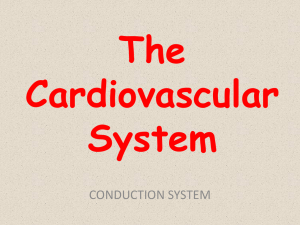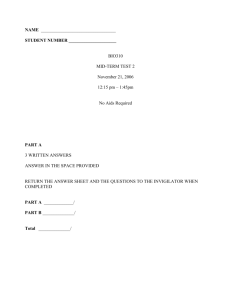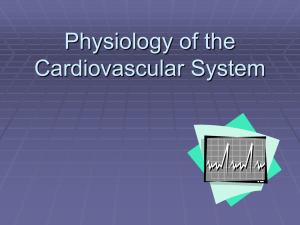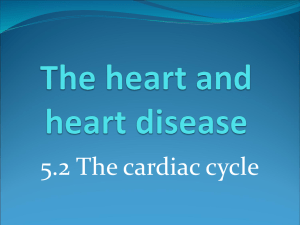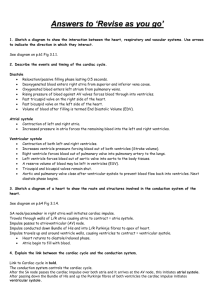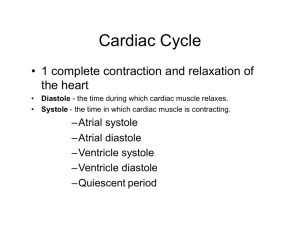THE CARDIAC CYCLE
advertisement
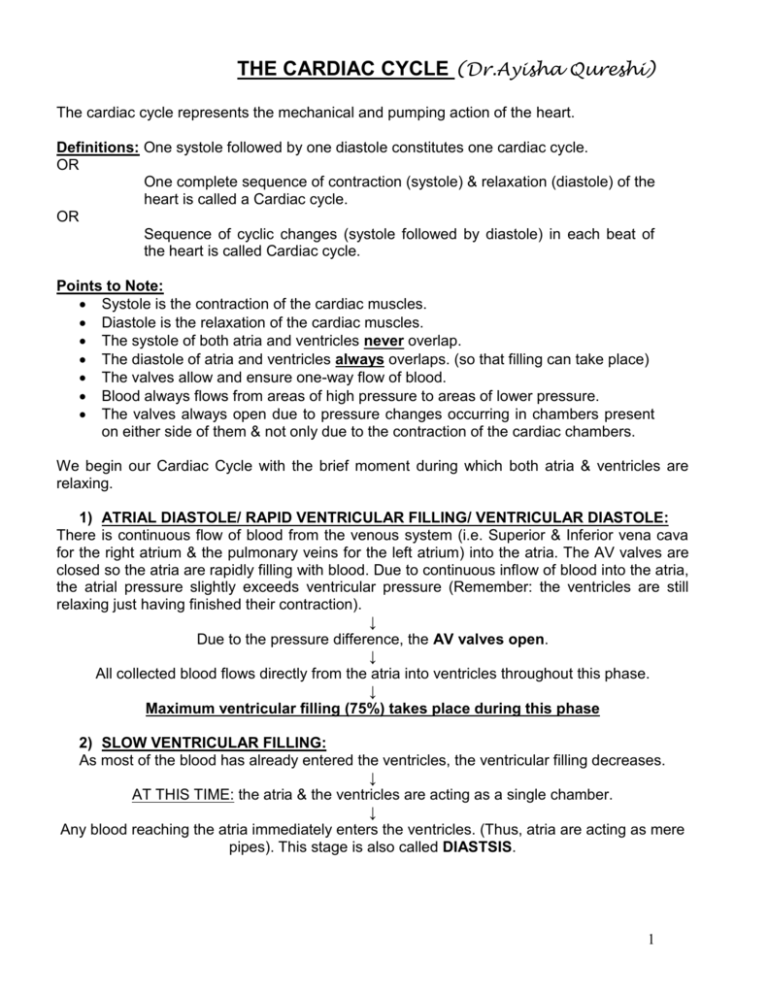
THE CARDIAC CYCLE (Dr.Ayisha Qureshi) The cardiac cycle represents the mechanical and pumping action of the heart. Definitions: One systole followed by one diastole constitutes one cardiac cycle. OR One complete sequence of contraction (systole) & relaxation (diastole) of the heart is called a Cardiac cycle. OR Sequence of cyclic changes (systole followed by diastole) in each beat of the heart is called Cardiac cycle. Points to Note: Systole is the contraction of the cardiac muscles. Diastole is the relaxation of the cardiac muscles. The systole of both atria and ventricles never overlap. The diastole of atria and ventricles always overlaps. (so that filling can take place) The valves allow and ensure one-way flow of blood. Blood always flows from areas of high pressure to areas of lower pressure. The valves always open due to pressure changes occurring in chambers present on either side of them & not only due to the contraction of the cardiac chambers. We begin our Cardiac Cycle with the brief moment during which both atria & ventricles are relaxing. 1) ATRIAL DIASTOLE/ RAPID VENTRICULAR FILLING/ VENTRICULAR DIASTOLE: There is continuous flow of blood from the venous system (i.e. Superior & Inferior vena cava for the right atrium & the pulmonary veins for the left atrium) into the atria. The AV valves are closed so the atria are rapidly filling with blood. Due to continuous inflow of blood into the atria, the atrial pressure slightly exceeds ventricular pressure (Remember: the ventricles are still relaxing just having finished their contraction). ↓ Due to the pressure difference, the AV valves open. ↓ All collected blood flows directly from the atria into ventricles throughout this phase. ↓ Maximum ventricular filling (75%) takes place during this phase 2) SLOW VENTRICULAR FILLING: As most of the blood has already entered the ventricles, the ventricular filling decreases. ↓ AT THIS TIME: the atria & the ventricles are acting as a single chamber. ↓ Any blood reaching the atria immediately enters the ventricles. (Thus, atria are acting as mere pipes). This stage is also called DIASTSIS. 1 3) ATRIAL SYSTOLE: SA node depolarizes ↓ Atria contract ↓ Atrial contractionforces a small amount of additional blood into the ventricles. Thus, Atrial systole is responsible for 25% of ventricular filling IMPORTANCE & UNIMPORTANCE OF ATRIAL SYSTOLE: In healthy individuals loss of atrial contraction usually causes no symptoms at rest or perhaps only a sensation of irregular or rapid heartbeat. ADVANTAGE OF ATRIAL SYSTOLE: Question: what is the advantage of atrial systole if maximum ventricular filling has already occurred? Answer: Atrial systole provides a margin of safety when: 1. Heart rate increases as in exercise. As heart rate increases the phase that is decreased in duration is the diastasis. Thus, now atrial contraction will compensate for the amount of blood remaining in the heart. 2. Stenosis of the AV valves: As flow of blood from atria to ventricles is impaired due to narrowing of the valve, so atrial contraction will force blood through the narrowed opening between the chambers. Pressure increase that accompanies the contraction also pushes a small amount of blood backwards into the veins. Although the opening of the veins narrows during contraction, there are no one-way valves to stop the backward flow. Thus, the retrograde flow into the veins may be observed as a pulse in the Jugular vein in a normal person who is lying with the head & chest elevated about 30°. This is called the Jugular Venous Pulse. 4) END OF VENTRICULAR DIASTOLE: Ventricular diastole ends at the onset of ventricular contraction. By this time, atrial contraction & ventricular filling are complete. The volume of blood in the ventricles at the end of diastole is known as END DIASTOLIC VOLUME. See: CARDIAC CYCLE VOCABULARY for: END DIASTOLIC VOLUME 5) ISOVOLUMIC OR ISOVOLUMETRIC VENTRICULAR CONTRACTION: Cardiac impulse from the atria reaches (atrial cont. is complete by the time ventricular cont. starts) ↓ AV node and then to the Bundle of HIS and the Purkinje fibers ↓ Ventricles are excited ↓ Ventricles contract Ventricular systole or contraction begins at the apex of the ♥ as spiral bands of the ventricular muscle push the blood upwards towards the base. ↓ Ventricular pressure rises & immediately exceeds the atrial pressure ↓ This backward pressure forces the AV valve closed First heart sound created by the vibrations following closure of valve (lub of lub-dup) 2 ↓ The ventricular pressure continues to increase till it exceeds the aortic pressure & will cause the opening of the aortic valve (Between the closing of the AV valve & opening of the aortic valve is a brief period during which the ventricles remain a closed chamber-as both valves are closed, no blood can enter or leave the ventricles during this time) (ANALOGY: Squeeze a toothpaste tube with the cap still on. Increased pressure will develop in the tube, but the toothpaste has nowhere to go.) ↓ This is called ISOVOLUMETRIC (constant vol. & length) VENTRICULAR CONTRACTION. (Similar to Isovolumetric contraction of the skeletal muscle) ↓ During this phase: 1. Ventricular pressure continues to increase 2. Volume remains same. 6) RAPID VENTRICULAR EJECTION PHASE: When ventricular pressure exceeds aortic pressure ↓ Semilunar valves opened ↓ Blood leaves the ventricles with great force & enters the aorta. ↓ High-pressure blood is forced into the aorta, displacing the low-pressure blood that fills them & pushing it further into the systemic circulation. ↓ These arteries on receiving more blood than they can pass on become distended ↓ Intraventricular pressure reaches its peak ↓ ALMOST 70% OF VENTRICULAR EMPTYING TAKES PLACE 7) SLOW VENTRICULAR EJECTION PHASE: After attaining the maximum ejection, the further contraction of ventricles is slow & weak ↓ Ventricular pressure starts falling ↓ Less blood flows into the aorta ↓ This phase is responsible for 30% of ventricular emptying See: CARDIAC CYCLE VOCABULARY for: END-SYSTOLIC VOLUME (ESV) STROKE VOLUME (SV) EJECTION FRACTION (EF) 3 8) ISOVOLUMETRIC RELAXATION PHASE: Ventricles start relaxing after having just finished their contraction ↓ Intra-ventricular pressure falls steeply ↓ Falls to lower level than aorta ↓ Blood starts to flow back into the ventricles again ↓ Backflow of blood fills the cuplike cusps of semilunar valves ↓ Forces the semilunar valves closed (See: CARDIAC CYCLE VOCABULARY for DICROTIC NOTCH) ↓ Second heart sound produced (dup of lub-dup) due to vibration of this valve closing ↓ Ventricles become a sealed chamber because AV valve is also closed as the ventricular pressure though falling is still higher than the atrial pressure ↓ During this phase: 1. The pressure in the ventricles is falling 2. The volume stays the same 1) ATRIAL DIASTOLE/ RAPID VENTRICULAR FILLING/ VENTRICULAR DIASTOLE: When ventricular pressure drops to the point at which the atrial pressure exceeds the ventricular pressure, the AV valve opens….. CARDIAC CYCLE STARTS AGAIN!! CARDIAC CYCLE VOCABULARY: Systole: cardiac muscle contraction. Diastole: cardiac muscle relaxation. End Diastolic volume (EDV): It is defined as the maximum amount of blood in the ventricles at the end of the ventricular diastole. No more blood will be added to the ventricles during this cycle. It is about 135 ml. End Systolic volume (ESV): Amount of blood remaining in the ventricles at the end of systole when ejection is complete is called End systolic volume (ESV). It is about 65 ml. This is the least amount of blood that the ventricle will contain during this cycle. Stroke volume (SV): Amount of blood pumped out of each ventricle with each contraction is called the stroke volume. SV= EDV − ESV = 135 − 65 = 70 ml Ejection fraction (EF): It is the fraction of the end-diastolic volume that is ejected. It usually equals 60%. Dicrotic notch: At the onset of ventricular diastole, closure of the aortic valve produces a disturbance or notch on the aortic pressure curve known as the dicrotic notch. This is caused by backward flow of blood (due to elastic recoil in the aortic walls) immediately before closure of the aortic valve followed by sudden stoppage of backflow. This notch is also called Incisura. 4
